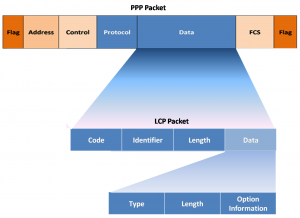LCP Options
PPP support different option than can be configured optionally. Authentication using PAP or CHAP, Compression using either Stacker or Predictor and Multilink that combines two or more channels to increase the WAN bandwidth. To negotiate these PPP options, the LCP link-establishment frames contain option information in the data field of the LCP frame, as shown in Figure 1. If LCP frame has no configuration option, then the default value for that configuration option is assumed. This phase is complete when a configuration acknowledgement frame has been exchanged. The configurable LCP options for specific WAN connection may include the following LCP options:

Authentication
This 16 bits long field with a code value of 0x03. This Configuration Option provides a method to negotiate the use of a particular protocol for Authentication. By default, authentication is not required. Password Authentication Protocol (PAP) and Challenge Handshake Authentication Protocol (CHAP) can be used for authentication.
Compression
Compression option is used to Increases the effective throughput on PPP links. Increasing throughput is possible due to reducing the amount of data in the frame that must travel across the link. The protocol decompresses the frame at the receiving side. Stacker and predictor protocols are used for this purpose.
Magic Number (Error Detection)
The Magic Number field is used for detecting links that are in a looped-back condition. It is responsible to ensure a reliable, and loop-free data link. Until the Magic-Number Configuration Option has been successfully negotiated, the Magic-Number must be transmitted as zero. Magic numbers are randomly generated number used to identify one end of a point-to-point connection. Each side of the link negotiates its magic number. If both sides discover that the magic numbers they are negotiating are the same, both side attempts to change its magic number. If the magic number remains the same after changing, the session terminates because of the loopback that is found.
PPP Callback
PPP callback option is used to improve security the in PPP links. Cisco router can act as a callback client or a callback server in the LCP option. The call back occurs at the beginning of a new PPP session. LCP includes the callback option and its settings. The client makes the opening call, requests for server call back, and terminates its call. The callback router answers the call and makes the return call to the client based on its configuration statements. The command is PPP callback [accept | request]. RFC-1570 further describes PPP callback.
Multilink
The multilink option is used for load balancing over the router interfaces that PPP uses. It is also referred to as MP, MPPP, and MLP. It provides a method for spreading traffic across multiple physical WAN links. Multilink indicates to its peers that it is capable of combining multiple physical links into a single bundle. A system indicates to its peer that it is prepared to do multilink by sending the multilink option as part of the initial LCP option negotiation.

